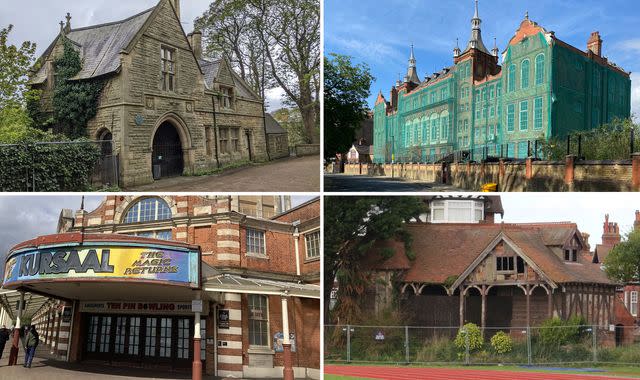One of the world's first amusement parks among UK's most 'endangered' Victorian buildings

One of the world's first purpose-built amusement parks and a nineteenth-century banquet hall for industrial labourers have been ranked among the UK's most "endangered" Victorian buildings.
A Gothic coastal villa in Devon and one of the earliest tennis pavilions in the world also feature on the list compiled by the Victorian Society.
The charity, which is dedicated to the preservation of buildings from the Victorian era, has featured the sites on its annual list of structures in need of rescue and repair.
Each of the sites are Grade II-listed or above, meaning they are subject to regulations protecting their historical and architectural significance, but the charity said in some cases it feared this was not enough.
Here is the list:
The Kursaal, Essex
The building in Southend-on-Sea is one of the world's first purpose-built amusement parks with a circus, ballroom, arcade, dining hall, billiard room, zoo and ice rink.
Designed by architect George Sherrin, it opened in 1901.
Today, a lonely Tesco Express is all that occupies the Grade II-listed site after it was forced to close in 1986 following an unsuccessful campaign to save the attraction.
Jesmond Dene Banqueting Hall, Newcastle
This banquet hall was built in 1860 for employees of the wealthy industrialist William Armstrong.
It subsequently expanded with a gatehouse, reception hall and display room in the following decade.
The Victorian Society said it is now "in a state of increasing decay" and may soon be unable to support the artists who now use it as a studio.
Bramcote Tennis Pavilion, North Yorkshire
Built in Scarborough in 1885, this veranda-style bungalow was once a lawn tennis pavilion and among the earliest structures built for the sport around the world.
It was commissioned for the North of England Lawn Tennis Club.
Kennington Boys' School, London
Built in the 1890s, this boarding school was requisitioned as a hospital during the First World War.
The English writer Vera Brittain served as a nurse here during the conflict.
The building was used as a school again after the war.
St Luke's Chapel of Nottingham City Hospital, Nottinghamshire
This chapel was built in 1902 as part of the Bagthorpe Workhouse for the use of inmates and staff.
Until the mid-1980s, the chapel was opened daily for use the of patients, staff and visitors at Nottingham City Hospital.
St Martins (formerly Roslyn Hoe), Devon
The Victorian Society says this Gothic coastal villa, built in 1880, is notable for its "fine decorative detail".
Coastal bathing resorts were said to have been growing in popularity at the time due to the expansion of railway links.
Chances Glassworks, West Midlands
The glassworks, which dates back to 1847, has supplied glass for iconic buildings around the world - including the White House and the Houses of Parliament.
The building in Smethwick features a seven-storey warehouse, bridges, and a rare type of furnace which is probably the last existing example in the world.
St Agnes' Vicarage and Hall, Liverpool
Built in 1887, the vicarage and hall were commissioned by the Horsfall family, a Liverpool stockbroking dynasty, which funded seven churches across Merseyside.
Both buildings are now in a "very poor state of repair", the Victorian Society has said.
Read more:
Rooney reveals he played 'mad' game of golf with Trump
Suspended chief constable's war medal 'appears to be false'
'Manhattanhenge' draws New Yorkers to the streets
Former education department offices, Derbyshire
This renaissance-style palazzo dates back to 1871 and housed the offices of Derby's education department.
It was more recently used as a popular nightclub - Berlins - then, at the millennium, changed hands to become a different club, which in turn closed in the mid-2000s.
It was sold again in 2009 but has since remained unused.
Comedian and actor Griff Rhys Jones, the Victorian Society's president, said the list was "a testament to the excitement, variety and invention of the Victorian Age".
"How terrifying to see buildings I have known, loved or used all my life ... in need of rescue," he added.
"But come on. Look at the character on display here. They all add colour and story to any urban landscape.
"Their restoration and reuse make huge commercial sense. They are attractions in themselves. They are already destinations. They should be part of local pride."
This is the fourteenth list of endangered buildings released by the Victorian Society, which was founded in 1958.


